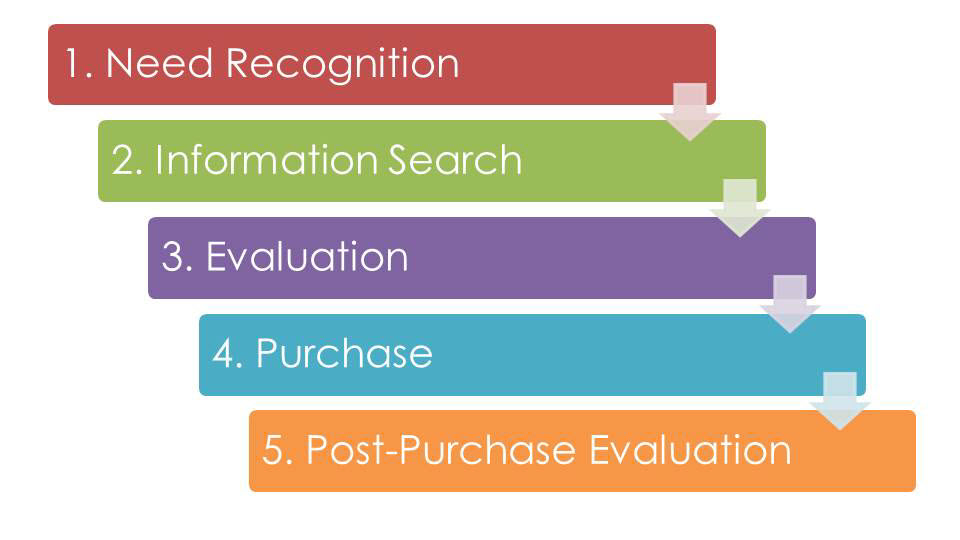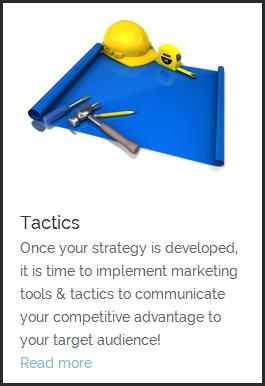Before you can select from all the marketing tactics available to you, you need to understand the process your customers go through in making a buying decision. What they’re thinking and feeling at each stage is what will help you determine the best way to reach your potential customers.
There are five steps to the decision-making process that customers go through when they make a purchase:

Step 1: Need Recognition and Problem Awareness
The buying process starts with a customer identifying a problem or need. It could be something like, “I’m hungry,” “I need a new lawnmower,” or “I don’t feel safe.” The customers may not identify this problem themself, but may be responding to an advertisement or stimulus. For example, you might walk by a chocolate shop and suddenly feel an intense “need” for truffles.
The distance between the current situation of need and the ideal future that fulfilling the need will create determines the strength of the customer’s motivation to meet that need.
Let’s consider an entrepreneur who realizes they need to automate some aspect of their business. If this automation will save her ten minutes a day, she will feel differently about it than if it would save her one day each week. The one day per week option will elicit a much more emotional response from her.
It’s good to understand just how much meeting this particular need will help your customer. A customer whose ideal situation is vastly better than their real, current situation will be much more emotionally motivated. For a customer whose ideal situation wouldn’t be much different than their current one, you would rely less on emotional marketing and more on presenting objective facts and data.
Step 2: Information Search
At this stage, the customer has realized their need and they’re gathering information on how to best meet this need. During this phase, customers pay more attention to information that comes from friends, family, or other consumers than the official advertising message of the company. They’ll also rely on their own feelings about the brand (for example, this security company is known for the strength of its products). In other words, people tend to rely on social information more than information from the marketers themselves.
It’s good to understand the sources that your customers use for their information. These could be:
- Personal sources: Friends, family members, neighbors, co-workers, and other acquaintances they trust.
- Commercial sources: Branding, advertising, salespeople, retailers, and point-of-sale displays.
- Media sources: Any kind of media including the Internet, TV, magazines, newspapers, etc.
- Experiential sources: A customer’s firsthand contact with the product (for example, taking a free trial or handling an item in a store).
As we said before, people tend to rely on personal, public and experiential sources of information at this stage more than commercial sources. People judge information from these sources as being more objective, as they have no vested interest in whether you buy the product or not.
Step 3: Evaluation of Alternatives
At this stage, the customer is checking out alternative brands, products, and services in order to choose what they perceive as the best choice.
Purchases can be divided into two types: High-involvement and low-involvement. High-involvement purchases usually involve those that are high-priced or that involve a great deal of personal risk, such as a house, a car, an investment, or any other major purchase. They can also include items that the customer has a great deal invested in, even if the monetary price is not high.
On the contrary, low-involvement purchases are those that are low-priced or involve little risk. These include choosing basic food products, entertainment products, soft drinks, and so on.
The evaluation stage is much more drawn-out and complex for high-involvement purchases. For example, people spend a great deal of time checking out different models for their next major car purchase. On the other hand, low-involvement purchases are made with little evaluation of alternatives because there is little risk involved.
Step 4: Purchase
At this point, the customer takes the information they’ve gathered and the evaluation they’ve made, and uses this information to make the purchase that will help them meet their initial need.
This is a very simple step, but it’s still important to consider because it can be affected by a number of factors at the point of sale. These factors include customer service, ease of the shopping experience, shipping and return policies, promotions, and so on.
A customer who has chosen a brand for purchase may change her mind at the last minute due to difficulties during the actual buying process. An in-store promotion may sway a customer to change their purchase choice from the one they made at the information and evaluation stage, especially for a low-involvement product.
Step 5: Post-Purchase Evaluation
Once the purchase is made, we’re not quite finished yet. The product needs to deliver on the promises it made. It needs to be in sync with the evaluation the customer made. Other factors like customer support may also play a significant role here.
There are a few things you can do in order to ease the entire process and cut down on buyer’s remorse after the purchase is made:
- Show that you understand the customer’s situation and focus on solutions to their problems.
- Provide clear and easy-to-understand information about your product or service.
- Encourage comparisons with similar products offered by competitors.
- Make the purchasing process as easy as possible.
- Provide an outlet for the customer to leave their feedback, such as through reviews.
Learning Activity:
Think about your own decision making process for finding a new dentist for yourself or your family. What are you thinking, feeling, and asking yourself at each step of the process? What information do you need at each step?
Now think about the decision making process your customers go through when deciding whether to buy your own products or services. See if you can answer the same questions. If you have access to a few of your customers with whom you have a good relationship, ask them directly.








